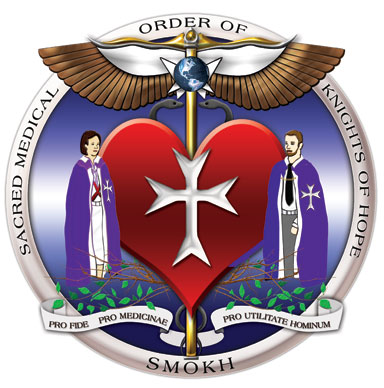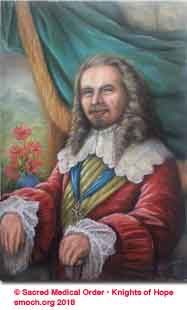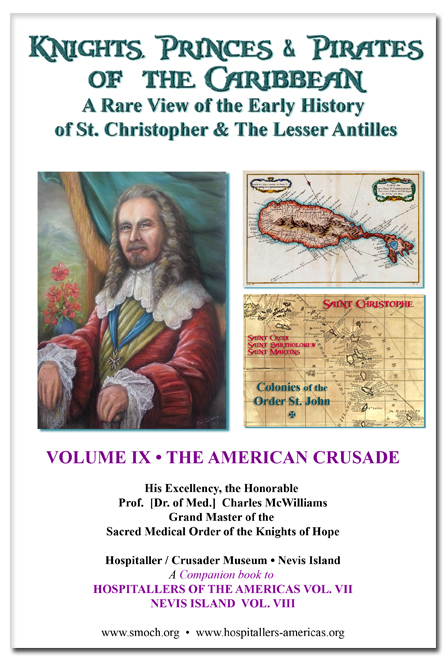 KNIGHTS OF THE CARIBBEAN ™
KNIGHTS OF THE CARIBBEAN ™  KNIGHTS OF THE CARIBBEAN ™
KNIGHTS OF THE CARIBBEAN ™ Phillippe de Longvilliers de Poincy, Godfather of the Brethren of the Coast
by Msgr., Hon. Prof., Dr. of Med. Charles McWilliams
• Grand Master of the Sacred Medical Order of the Knights of Hope, Ecuador • Nevis • Puerto Rico • Florida • Curacao
 |
Phillippe de Longvilliers de Poincy (1584–1660)[1] was a French nobleman and Bailiff Grand Cross of the Knights of Malta. He governed the island of Saint Christopher from 1639 to his death in 1660, first under the Compagnie des Îles de l'Amérique and later under the Knights of Malta themselves. Poincy was the key figure in the Hospitaller colonization of the Americas. Poincy instructed the Huguenot Levasseur with sixty buccaneers, to drive the English out of Tortuga and notified the French Ministry that he was Governor of Tortuga. Levasseur was successful, and on 6 November 1640 a treaty was drawn up between Poincy and Levasseur, appointing him Governor of the island under the flagship of St. Christopher (today St. Kitts), which allowed religious toleration and trade between the two islands; but more importantly, the division of booty between the two. Poincy had financed the entire operation and supplied the ship for Levasseur to travel from Basseterre to Tortuga.
|
By 1641, the French engineer Jean La Vasseur raided the island with a force of between fifty and one-hundred men, claiming the primary port as sovereign. Aware of the predations of the Spanish, La Vasseur under the instruction of Poincy had Fort de Rocher constructed overlooking the harbor, thus fortifying it from further foreign assaults. With its cannons and steady oversight of vessels approaching the harbor on the southeast coast, the fort gave La Vasseur a high degree of control over the island. La Vasseur was effectively Lieutenant Governor of Tortuga, while Poincy also governed St. Croix, St. Martin, and Barthélemy.
The sovereign claim to Tortuga greatly increased the reputation of La Vasseur, Tortuga, and it's Buccaneers. One of its previous Governor's was Anthony Hilton, who traveled back to Nevis and became Governor there earlier. The official lawlessness of the region appealed to all of the seafaring brigands in the Caribbean, particularly those pirates out of La Rochelle, France. La Vasseur opened the port to outlaws of all nations in exchange for a percentage of the wealth of every vessel anchoring there. All pirates needed a safe place to berth, and a town that was respectful of their careers was a prime one. Tortuga quickly became the first great pirate outpost.
"Under the wise governorship of M. Levasseur the little settlement prospered. French and English adventurers of all sorts gathered there, planters, buccaneers and runaway sailors. The buccaneers hunted cattle on the neighbouring island of Hispaniola, the planters grew crops of tobacco and sugar, while many of the former, now become full-blooded pirates, roamed the neighbouring seas in search of Spanish ships to plunder. Tortuga soon became the mart for the boucan and hides brought from Hispaniola, and for plunder taken from the Spanish, which were bartered for brandy, guns, gunpowder and cloth from the Dutch and French ships which called there. It was not long before the fame of Tortuga had spread all over the West Indies, to be followed by a rush of adventurers of all kinds, to whom the attraction of cruising after the Spaniards with its opportunities of sudden wealth was irresistible. Such extremes of fortune have always attracted a certain class of dare-devil character and the situation was not unlike that met with during the days of the "forty-niners" in California, or the rush of gold-seekers to the Klondyke in 1897." (The History of Piracy, Philip Gosse, 1934)
The infamous Flibuste period will create a company comprising English, French and Dutch. They will adopt a social organization of the Republican type, the "Brothers of the Coast", which will include an embryo of "social security" for injuries received in combat, a depot to exchange goods, taverns, pubs, and brothels. This society will remain welded despite the clashes of the national powers of "guardianship". At the end of the seventeenth century, the declining Flibuste moved pirate operations to Jamaica in Port Royal (Kingston) which was dominated by English pirates like Henry Morgan, and Nassau to the Bahamas (New Providence island).
Thus, by the establishment of Tortuga by de Poincy as a territory under St. Christopher rule, and this island would became the capital of the Brethren of the Coast under Le Vasseur, and thus we could say effectively that Phillipe de Poincy is the Godfather of the Brethren. By definition, “a man who is influential or pioneering in a movement or organization,” — Poincy is the Godfather of the Brethren of the Coast, a startling revelation about pirate history.
 |
You can read all about this fascinating history in the author's book: KNIGHTS, PRINCES & PIRATES OF THE CARIBBEAN
|
The Hospitaller colonization of the Americas occurred during a 14-year period in which the Knights of St. John (Knights of Malta) possessed four Caribbean islands: Saint Christopher, Saint Martin, Saint Barthélemy, and Saint Croix.
The Knights' presence in the Caribbean grew out of their order's close relationship with the French nobility and the presence of many members in the Americas as French administrators. The key figure in their brief colonization was Phillippe de Longvilliers de Poincy, who was both a Knight of St. John and governor of the French colonies in the Caribbean. Poincy convinced the Knights to purchase the islands from the bankrupt Compagnie des Îles de l'Amérique in 1651 and remained to govern them until his death in 1660. During this time, the Order acted as proprietor of the islands, while the King of France continued to hold nominal sovereignty. However, Sir Poincy ruled largely independent of them both. In 1665, the Hospitallers sold their rights in the islands to the new French West India Company, bringing their colonial project to an end.
The Antillean Order of St. John of St. Christopher/Nevis is the 21st century, fresh and first major impetus to present the medical corps history of the monastic/military orders, as best as it can be reconstructed of the medieval records, first recounted by Edgar Hume’s Medical Work of the Knights Hospitallers (1940). In this book, it will be seen that the Hospitaller Orders developed medicine, surgery, and nursing as an organized form of hospice and hospital care that sprang from the Ten Commandments, and from the Old and New Testaments, which has been one of the most stabilizing factors of peace in western culture. Many customs and accepted civilized behaviors like the manners of a gentleman, the respect for marriage, rules of engagement, diplomacy, etc. sprang from the Codes of Chivalry that so few recognize nor respect today.
Through the reemergence of the Antillean Sacred Medical Order of the Knights of Hope for the 21st century, a new chapter in their medical history is being developed. Incorporated as early as 2006, this Order has reemerged the Order of St. John in the Federation of St. Kitts/Nevis where it originally settled in 1639. A museum and Chapel has been constructed and formally opened to the public June of 2017 as testament to this rich and unique history. Many Goverment dignitaries of the islands are now members of this Sacred Antillean Order. The Knights Hospitallers are once again establishing itself as a functional order, dedicating itself to meeting the spiritual and medical needs of the poor and sick so they once again dedicate themselves to following the example and teachings of our Lord Jesus Christ.
In order to accomplish its goals, the Order has built on the traditions and foundations of over one thousand years of medical history in a modality called monastic medicine. The Order maintains a monastic medical center on Nevis which services more than 6,000 patients of the Leeward Islands. With his emphasis on the medical history of the Order, Grand Master, professor Charles McWilliams has provided the historical foundations in a series of seven books. With this seventh volume, we record the medical achievements and history of the Hospitallers of the Americas, providing heretofore an untold saga, as a unique reference for those studying the history of medicine, and the Christian orders that shaped ambulance care (the Red Cross and St. John Ambulance), surgery, hygiene, and natural medicine (naturopathy). All members of the Order are indeed grateful for the works and scholarly insights of Grand Master McWilliams. May the Knights Hospitallers continue to serve through its humanitarian actions, and may all our earthly endeavors be to glorify God.